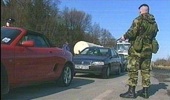
A British soldier has said that locally recruited RIR soldiers allowed two well-known unionist paramilitaries, stopped a short distance from the home of human rights lawyer Rosemary Nelson shortly after her murder, to escape.
Christopher Jopling of the British Army’s Royal Military Police told the inquiry that he had been on patrol with the two RIR (formerly UDR) soldiers in Lurgan, County Armagh shortly after Mrs Nelson was killed by an undercar booby trap bomb on March 15 1999.
Mr Jopling, who is still a serving soldier, said his position while on duty in Portadown in the late 1990s had been to act as a British military ‘spotter’ identifying republicans and loyalists in the mid-Ulster area.
Within minutes of Mrs Nelson’s murder his patrol set up a roadblock at North Circular Road and Lake Street in Lurgan, a short distance away from Mrs Nelson’s home.
He revealed how a car containing the two loyalist suspects was stopped at the checkpoint.
“I remember this as they were believed to be loyalists and were in a staunchly republican area,” he said.
“I spoke with both men who said they’d been visiting the graveyard.
“I can’t remember this conversation now but remember that the graveyard was in a Catholic area and therefore it would have been strange for them to have been there.
“I’m surprised that they and their vehicle were not searched at the time, given their explanation.”
However, Mr Jopling said that when he asked the patrol commander, identified only as A620, to alert his superiors back at base to the fact that two known loyalists had been spotted in the area of the killing, he was told: “I probably won’t bother with that. You know, there is no need.”
In a statement to police, Mr Jopling said that A620 was very verbally aggressive to Catholics and “always reluctant to pass details of loyalist sightings and would encourage officers in his patrol to do the same”.
The inquiry also heard evidence that the RUC police had observed the man who made the device which killed Mrs Nelson as he met with the LVF in Lurgan weeks before Mrs Nelson was murdered -- but did not intervene.
The device, which used a mercury tilt-switch from the Shorts industry in east Belfast, was passed to the LVF by way of Johnny Adair’s ‘C’ company of the UDA.
Adair is known to have had strong links with both the RUC Special Branch and the LVF, which was the strongest unionist paramilitary group in the area where Mrs Nelson lived.
The bomb-maker was not publicly named in the inquiry, but reports identified him as east Belfast loyalist Thomas ‘Tucker’ Ewing, who died of a sudden illness last year.
INQUEST ORDER
Meanwhile, PSNI chief Hugh Orde has been ordered to pass a listing of relevant documents to the parents of Pearse Jordan, who was gunned down by the RUC following a car collision on the Falls Road in November 1992.
A High Court judge ruled, however, that the Jordan family should be given only “non-sensitive” files from those previously supplied to a coroner.
A long-delayed inquest into the shooting is due to open next month.
![[Irish Republican News]](https://republican-news.org/graphics/title_gifs/rn.gif)
![[Irish Republican News]](https://republican-news.org/graphics/title_gifs/harp.gif)

